
We are celebrating 15 years — and counting — of stories that are deeply researched and deeply felt, that build a historical record of what the city has been.
We are celebrating 15 years — and counting — of stories that are deeply researched and deeply felt, that build a historical record of what the city has been.
Robin Chase co-founded Zipcar, the world’s largest car share service, in Cambridge, MA in 2000. You can now share Zipcars in Atlanta, Boston, Chicago, London, New York, Philadelphia, Pittsburgh, Portland, San Francisco, Seattle, Toronto, Vancouver, Washington DC and at university campuses across the country. The last couple years she’s been working on GoLoco, which aims to do for ride sharing what Zipcar did for car sharing: to make it easy, efficient and commonplace to share car travel, split costs, and reduce emissions. Urban Omnibus recently teamed up with our friends at The Infrastructurist to ask Robin about everything from mesh networks to taxi stands to why the infrastructure we build determines our destiny. Make no mistake: she thinks BIG.
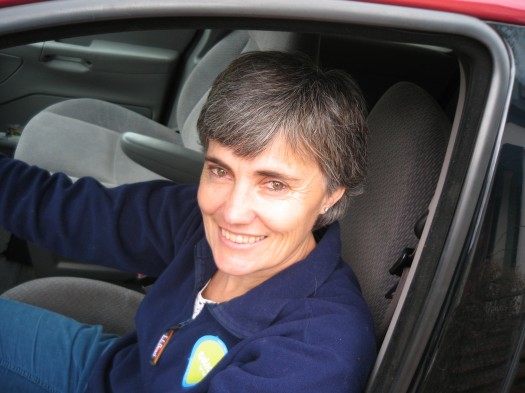
Image courtesy of GoLoco
Tell us a little about the founding of Zipcar.
For some innovations, there really is a perfect moment of confluence. It was like that with Zipcar. Zipcar was launched in June of 2000. My co-founder is German, and car sharing as we know it originated in Germany. One day she was sitting at a café in Berlin, and she saw a shared car across the street. She came back to Cambridge and she asked what I thought of this idea. I had just come from my 10th business school anniversary, and this was the height of dot-com mania. Starting a company seemed like an obvious idea.
At the time, wireless was being talked about endlessly. It was the new cool thing. But the only wireless application people had thought up was cell phones. Zipcar was a very early application of wireless that wasn’t cell phones. I thought, “Wow, this is what the Internet was made for: sharing a scarce resource among many people. This is what wireless was made for: we can make transactions very easy for end users and brokering those transactions will cost us next to nothing.”
Besides, this is what I wanted personally. I have three kids and one car that my husband takes to an office where it sits, unused, for eight hours a day, so I never have access to a car. Plus, I live in a city and there’s no way in hell I want to have a second car that I have to maintain and own and park. The lightbulb went off: the costs for car ownership definitely outweigh the benefits for me in the city, and wireless and the Internet can make this easy.
The environmental piece of it was obvious, and if I hadn’t perceived a sustainable business model, I wouldn’t have started it. I don’t think I would have started a business that had no social benefits because I wasn’t interested in spending 120 hours/week for years doing something that was just to make money.
This is what the internet was made for: sharing a scarce resource among many people. And here we are nine years later. What’s really striking is how things have changed that people don’t even consider. When we started, 25% of adults had cell phones, and only 50% of people had access to the Internet, and that was at work. So we were operating in an environment, from a technology perspective, where I felt I knew where the trends were going, we just had to make significant strategic decisions based on those trends. Looking back, one of the things that Zipcar taught me was that sharing an asset is incredibly fabulous for everyone involved. When you share a car, it’s great for companies, great for individuals, great for cities.
When I learned about mesh networking, I thought, “Wow! This is exactly the same kind of thing on a much bigger scale.” I love the beauty of the economics of it: individuals will happily pay for individual devices to perform a specific service, but in so doing build a communications infrastructure. I was totally fascinated with this concept. It’s so beautiful from an economic standpoint: just how huge the unanticipated benefits are when sharing a device.
I believe in a heartfelt way that energy efficiency has to do with behavior, and behavior is driven by price and ease of use. By simplicity. For cars, the only way we will change our driving habits is when we’re paying the real cost of driving: including the cost of carbon, the cost of congestion, the cost of building and maintaining the roads. And the easiest way to be able to pay the real cost of transportation would be if we had ubiquitous data grids. It’s the same thing that we talk about with the smart grid: dynamically priced power consumption, with the real price of what it’s costing.
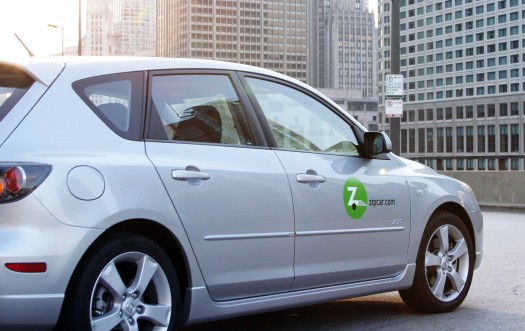
Image courtesy of Zipcar
People love the idea of smart buildings, with sensors everywhere. But the sensors have to go back to someplace. They have to go back to someone who’s paying attention to what those sensors say. What we need is a ubiquitous database to help us A) price energy correctly, and B) not to have to think too hard about it. For example, no matter how many times I tell my son to turn the lights off before going to bed, he forgets to do it. Wouldn’t it be great to have all those sensor networks that we know about to turn it off for him! When it’s 2am and no one has moved in the house for the last hour, perhaps it’s time for sensors to turn all the lights off.
If you’re asking me to make the analysis of what times of day and night I use my hot water heater, and to turn it down accordingly, it will never happen. If you ask the gas company to do an analysis of people’s water heaters and then to ask me, “Robin, do you want us to turn it down and save yourself $40 over the year?” I’ll say, “Of course.” With a ubiquitous data grid, we could rely on technology to make it easy for us to use resources more efficiently. We could price things more accurately. Technology will play a big role in how we handle our energy consumption.
What do you see as the role of government in handling our energy consumption?
Some in Washington are willing to do what’s difficult, but many in the House and in the Senate are not. The political reality drives me crazy: people have been pushing off the need to raise gas taxes for 18 years now and there’s only so long you can go without maintaining your roads or building your bridges or financing your transit systems. We’ve kicked the can down the road and we can only do that for so long.
Infrastructure is destiny yet infrastructure, typically, is not adaptable… We need to make flexible infrastructure. In your city, in New York, the head of the MTA Lee Sander, just resigned under that particular issue. He was saying that we need to solve this now, and the governor was saying, “You know what? Let’s come up with some creative financing solutions that don’t involve us paying this year, or the next year, or the year after.”
Fundamentally, I think all scales of government need to work on public information. Politicians say they follow what the people want, and the people want cars and roads, and they don’t want to finance public transit, and they don’t want to think about CO2 emissions, and they don’t want to pay for congestion.
When I talk to people, they’re often quick to say, “I’m paying my gas tax, why aren’t you maintaining the road” or “I’m paying the toll, I’ve done my duty”, and they don’t realize that they’re paying the price that built it 20 years ago, but what about maintaining and operating it? The public doesn’t make that connection, and I think the government needs to do a lot more educating.
So, as you have moved from Zipcar to GoLoco, from car sharing to ride sharing, do you see ride sharing as more of a national set of strategies?
Yes, car sharing only works in dense metropolitan areas or in cases where people don’t need a car to get to work. If you need a car to get to work, you’re going to have to own your own car. The cost of car sharing is too high for a daily commute. But, then again, according to the National Households Consumer Survey, across the nation it costs $24 per day on average that people are spending in America on their car, day in and day out. If I were to tell you that it was going to cost $125 a week to go to work, you would say, no way, I’m not going to do it. But we are doing it – we just don’t realize we’re doing it.
That’s why I did GoLoco – I said, what about all those other people who are feeling similar transportation and mobility pains but they need a car to get to work? Ride sharing is for those people.
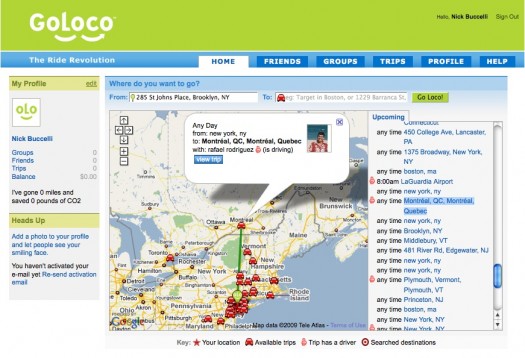
Screenshot: www.goloco.org
Can you give us ride sharing 101? How can GoLoco change how we get around?
The big idea for ride sharing and for GoLoco is to think of your car, your expenses, your friends, and your trips as part of your own personal public transportation system. Your friends and their cars and their trips are ways that you can get around. It builds on the idea of long tail media and long tail economics. Ride sharing is the long tail of public transportation. There are rides that serve little niches of demand way out there, in places where you’ll never see a bus service, or a public transportation service of any kind, but you would see ride sharing, because of the individuals who do go way out there. Basically, if you look at the long tail, ride sharing can meet the needs of small groups of individuals who need to get from a specific origin to a specific destination at a particular time.
I think when we look back at ourselves sitting alone in our 120 square feet of car, driving down these highways with incredible storage costs and incredible operating costs, I think we will look back at how we travel today and be just astounded: astounded at the cost, astounded at the waste. It’s such a wacky idea that we’d want to be alone in our cars spending huge sums of money and all that parking space, when it was less fun and more expensive and kind of crazy.
This is why I did GoLoco. We know that we can’t build our way out of congestion, so if things are increasingly, year after year, getting more congested, there’s only one solution for that: addressing the cost of driving over peak periods.
At $2 per gallon, people spend 18% of their income on their car, and that’s without paying for congestion pricing or tax increases or any other changes to transportation financing coming down the road. But it’s not in the control of any government to effect what the ultimate price of gas is going to be when we have increasing demand from India and China, and arguably peak oil. We have an increasing world population that will continue to drive cars with gasoline on our roads. Ride sharing is going to be significant while we transform our infrastructure to be less car-dependent. While we have such a high cost of car travel in such a car-dependent country, I don’t see another solution. 86% of trips made are alone in a car. Think about standing in a mall, looking at a parking lot. You know that a large number of people there are going exactly where you’re going in the next five minutes.
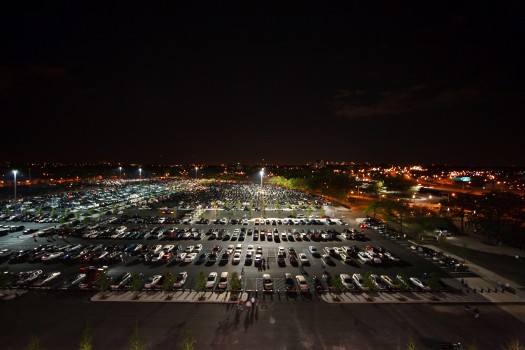
Photo: Tom Harrison
There are two ways to think about taxis. Taxis are great if we look at the percent of time that they’re in motion with someone going someplace. I bet it’s pretty high and they aren’t taking up parking spaces or any of that storage space, which is an excellent thing. But, if we think of taxis that are driving around in circles, that’s not so good.
And now there’s talk in New York of taxi sharing possibilities. I think the only time I ever shared a taxi was during the transit strike.
Exactly. People discuss whether ride sharing is something we can do or not do, culturally. But in a circumstance like a transit strike, or a taxi strike, within hours people were willing to share cabs. You could hop in a cab and instead of being one passenger in one car, suddenly we’re willing to have many people in a car.
The question of why we don’t share taxis is very similar to why we don’t share cars. One problem is that it seems culturally weird. When I get out at JFK, why can’t I ask the person standing next to me, “Where are you going, do you want to share a cab?” For some reason, that’s socially unacceptable. And then when you’re not at an airport, the problem becomes where to stand to even hail a shared cab to begin with.
On the street, one of the issues is a lack of visibility. When I think about taxi sharing, it’s the same thing. If you could tell me on the exterior of the taxi, if there was a sign that said “going to LaGuardia” or “going to 42nd Street,” if that were displayed on the outside, then it would be more easy for me to realize “Oh, I can share cabs and I can stick my hand out and catch this particular cab.” But right now it’s all kind of hidden, it’s not an obvious option.
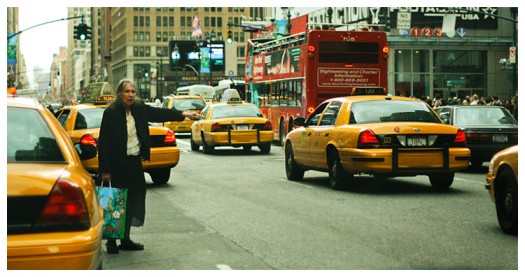
Photo by Flickr user Ykmm85
The Taxi and Limousine Commission just recently adopted the recommendation to develop group ride locations and ride share fares.
That’s great, and Manhattan has a good attribute that not very many cities have: it’s very vertical. Ride sharing relies on getting small groups of people together – you have to create critical mass. In Manhattan, if you have two people standing at on a corner there’s a good chance you’re both going uptown or downtown, so it’s possible to share a cab. But in a city where you have a lot more directions than uptown and downtown you’re going to have to have a lot more than two people standing at that corner to make it worthwhile.
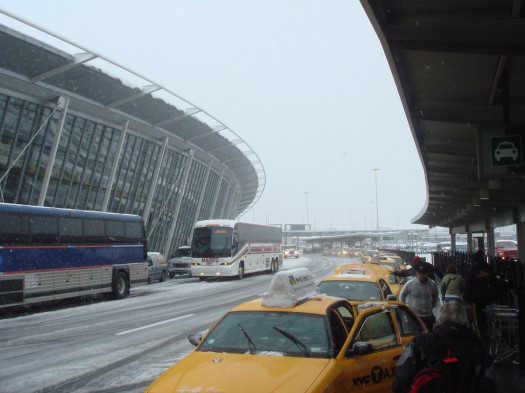
Photo by Flickr user dmboyer
I’ve heard you say, “Infrastructure is destiny?” Can you elaborate?
Infrastructure is destiny. Think about how we built out the national highway interstate network in the ’50s. We built highways, we ripped out all the trolleys, and we didn’t build any trains. We created our destiny as a car dependent nation because that’s the infrastructure we built up. When we think about sprawl, we must remember that we built our houses on one-acre lots and now our choices for interaction are defined by that.
I think a lot about it in terms of the internet as well. Countries that have a robust and low-cost internet infrastructure are the ones that have access to information and the ability to innovate. Our infrastructure allows us to do things in an easy way or to do things in a difficult way. And we all like to do things easily. When our infrastructure makes things easy and convenient, we do more of those things. When things are made difficult, we do less of them. We have set up our infrastructure to make getting in your car, going door to door really easy, as the cheapest, fastest way. Getting there by bike or by foot is frequently terrifying and dangerous, so which way do we go? So, yes, infrastructure is our destiny.
Are there other innovations right now that are particularly exciting to you?
At this very minute I’m hard at work putting together a project to build an open platform for cars that would make getting technology in your car more like downloading things onto your iPod. What I’m hoping to do is to put a technology platform on there that enables an infinite number of applications to be downloaded to a vehicle, enabling us to innovate on modes of access, ways of using the vehicle, ownership, use of time, how we understand our environment around us in terms of congestion and pricing and information.
Technology has a potential of making data exchange between everything simple and easy, but it’s siloed. Transportation technology today is closed and proprietary, so only GM gets to decide what goes onto an OnStar when there are a thousand things that could be interesting to do with a more open platform. But GM is making the choices and look at the choices they’ve made!
Are there other sectors, beyond transit, that you think are ripe for shared, use-on-demand systems?
Through the car platform I’ve been doing some lobbying in Washington to raise awareness about technology investments in all sectors – the smart grid, education, health care, transportation, etc. Instead of producing closed proprietary devices and closed proprietary networks, I’d like our political leaders to realize that it benefits everybody and lowers costs if devices and networks are multipurpose.
I’m very interested in looking at excess capacity everywhere.
In New York City, you have an example of a failed sharing. After 9/11 an emergency, wireless communication network was built. I think they spent 200 million dollars on that network just across Manhattan, and the network is not being used to capacity. Emergency responders will tell you that they don’t want to use the excess capacity in case they need it down the line. But what people fail to realize is that networks can give priority and can guarantee delivery to the party who gets that first priority. We could say that that 200 million dollar network built in New York City goes to emergency services first, every time, no question. But when there’s not an emergency there’s extra capacity left over and we pay for it as taxpayers. I’m very interested in looking at excess capacity everywhere.
The next phase is to look beyond climate change to a more general understanding of sustainability. With 6.7 billion people on the planet growing to 9 billion, we’ve already taken our planet to the limit. We’re going to be taking it past the limit, and so every single resource that we use we should scale up to its maximum capacity. And I would put dollars in that list of scarce resources.
Building stock – especially office space that’s not used at night – is an important resource that has a lot of excess capacity.
I was in Holland a couple of years ago and I was looking at the old, merchant row houses. The merchants who lived there initially had their shops on the ground floor with their families living above. With maybe three or four floors, each family could also have renters or storage space or a larger family. Those houses were so versatile. Some of the industrial warehouses we built in this country are like that, highly versatile. But then you compare them to the giant office high-rises that are made for offices with floor plans so gigantic that once you stop doing AT&T call centers there, there isn’t another blessed thing that you’d want to do in that space. We are building our infrastructure in a way that has almost no flexibility. It’s this particular thing that you’re doing there or that’s it.
So, again, what do you do about $5/gallon gas? Do we want to have four lanes of traffic for cars when maybe, sometime in the future, we may want to run a transit line down the middle, or do a dedicated bus lane, or have bicycles? My guess would be in 100 years it’s not going to be four lanes of single occupancy vehicles. I think the most successful solution is to produce things that can be adaptable, highly adaptable. Infrastructure is destiny yet infrastructure, typically, is not adaptable. That’s why it often plays out in bad ways. We need to make flexible infrastructure. Maybe that’s the new catch word.
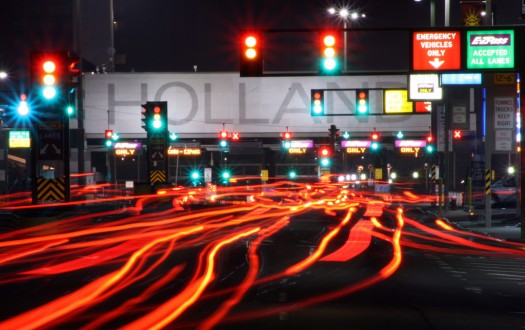
Photo: Tor-Erik Bakke
Interview conducted by Jebediah Reed and Cassim Shepard. Edited and condensed.
Homepage illustration by Shumi Bose.
The views expressed here are those of the authors only and do not reflect the position of The Architectural League of New York.
Comments